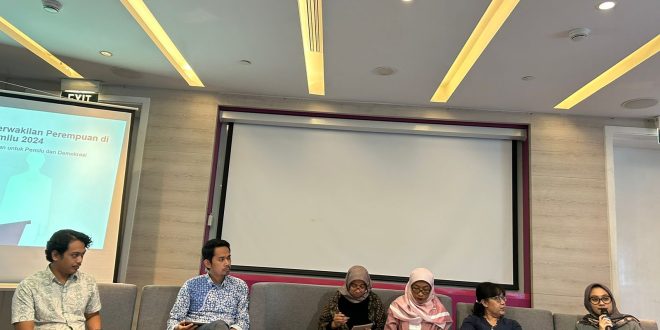The Association for Elections and Democracy (Perludem) released a study of the 2024 election results on the projection of women’s representation in the People’s Representative Council (DPR). As a result, the figure for women’s representation is projected to increase to 128 seats, or 22.1%, compared to the 2019 election with 20.5%, or 118 seats. Needem believes that in the sixth election since the 1998 Reformation, the figure for women’s representation should have reached 30%.
“Our conclusion is that if only the General Election Commission (KPU) could ensure that every electoral district had 30% female representation, the figure for female representation could increase even further than this,” said the Senior Researcher of the Duludem, Heroik Pratama, in the discussion “Projection of Women’s Representation in the DPR Election Results 2024” in the Menteng area, Central Jakarta (28/3).
Previously, the KPU, through PKPU/10/2023, was considered to have issued a policy that reversed the policy of affirming women’s representation in the form of a 30% nomination quota for women in parliament. This policy contains a formula for calculating women’s representation in the form of rounding down when determining the Permanent Candidate List (DCT) in each electoral district (dapil). The Supreme Court (MA) has corrected this policy through MA Decision No. 24 P/HUM/2023, which ordered the KPU to revoke the article on the grounds that it contradicts the Constitution, Law No. 7 of 1984 concerning Ratification of the Convention on the Elimination of All Forms of Discrimination against Women (CEDAW), and the Election Law. However, the KPU ignored the order until the DCT was determined.
As a result, at least 266 DCTs out of a total of 1,512 DCTs for DPR members determined and announced by the KPU do not contain provisions for women’s representation of at least 30%. Apart from that, another impact of this policy is that of the 18 political parties participating in the 2024 election, only the Prosperous Justice Party (PKS) meets the requirement of 30% female representation in 84 electoral districts, while not all of the remaining 17 political parties fulfill the quota for female legislative candidates.
“Compared to the previous election, there is a trend of increasing the number of women’s representation, but the number is not yet significant,” explained Heroik.
After the official announcement of the election results by the KPU, Perludem converted political parties’ vote tallies to measure party seats and the number of women’s representation in the DPR for each party. The calculation is carried out using vote acquisition data based on the model D vote recapitulation form. Results are sent via the Recapitulation Information System (Sirekap). According to Heroik, the figure for women’s representation is still very likely to change, depending on the decision on the General Election Results Dispute (PHPU) at the Constitutional Court (MK).
The projected number of seats for female legislative candidates is the PDIP Party, with 27 seats, or 24.5% of the total number of 110 party seats. Meanwhile, the Golkar party was filled with 20 female legislative candidates (19.6%) out of 102 total party seats; the Gerindra Party got 19 female legislative candidates (22.1%); the Nasdem Party got 21 seats (30.4%); PKB got 14 seats (20.6%); PKS got 9 seats (17%); PAN got 9 seats (18.8%); and the Democrat Party got 9 seats for female legislative candidates (20.5%).
“The total figure for women’s representation in the DPR RI is approximately 128 women who were elected, with a percentage of 22.1%.” This figure is still far from the standard of representation set globally,” explained Heroik.
Furthermore, Heroik explained that the serial numbers in the proportional system have no meaning, but it turns out that the figure for women’s representation is closely related to number one or two, who are considered priority legislative candidates. Meanwhile, only certain female legislative candidates who have close ties to party elites and strong sources of funds receive priority numbers. There are at least 73 female legislative candidates who were elected, namely legislative candidates with serial number 1, 26 legislative candidates with serial number 2, 18 legislative candidates with serial number 3, and 4 legislative candidates with serial number 4.
According to him, one of the factors causing the low representation of women is that the majority of female candidates are placed using numbers 3 and above. In fact, if you use the zipper system, number determination should be done using a male and female crossover system.
“On average, 60% of elected DPR members are placed at number 1, while the number of women placed at number 1 is still very far compared to men; the majority of women are at number 3,” he explained.
Meanwhile, there are 16 electoral districts that are projected to have no female representation at all, meaning that all the seats are filled by male legislative candidates. These electoral districts include Aceh I and Aceh II, Jambi, the Riau Islands, Central Java (Central Java) I, and the Mountains.
There are also electoral districts with women’s representation of 10%–28% spread across 28 electoral districts; meanwhile, there are 20 electoral districts with women’s representation of 30%–50%. Bengkulu is the electoral district with the highest percentage of female representation, with 100% of the seats filled by women. Five other electoral districts, such as West Java I, East Java I, North Sumatra, North Maluku, and Maluku, average 50%–100% female representation.
Responding to this, Senior Researcher at the Political Research Center of the National Research and Innovation Agency (BRIN) Kurniawati Hastuti appreciated the struggle of women legislative candidates because, in the quite bad conditions of the 2024 election, they could still consolidate themselves. However, unfortunately, the majority of the elected legislative candidates are those with strong resources and power; according to him, this is reflected in the fact that the legislative candidates who received priority numbers are legislative candidates who have ties to political dynasties.
“Actually, there are many challenges faced, apart from structural but also economic, because the political costs required are high. “Social investment in women’s networks is apparently not strong enough,” he said.
Meanwhile, Secretary General Mike Verawati of the Indonesian Women’s Coalition (KPI) said that 22.1% of women’s representation was still far from enough because the seats of female legislative candidates were not significant enough to determine policies from a gender justice perspective. It should have been a years-long struggle for affirmative action for women’s representation to reach 30% in the 2024 elections.
“In the 2024 election, 30% should be achieved, not stagnant. This might also be used as a road map for revising the Election Law regulations. “The system should be changed so that young people and women also have space,” he stressed.
The Habibie Center Program Director, Julia Novrita, believes that if the government does not seek and intervene in women’s representation, the democratic space for women will only be limited to 20%. According to him, this is also the impact of the many stigmas regarding women in society; for this reason, institutionalized efforts are needed to encourage women’s representation.
“If we want this country to have a better democracy, let’s work together to encourage women in politics,” said Julia. []
 Rumah Pemilu Indonesia Election Portal
Rumah Pemilu Indonesia Election Portal




